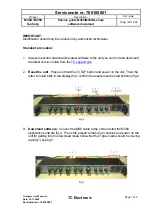
1-4
in the non-permanent static ARP entry, the device adds the interface receiving the ARP reply to the
non-permanent static ARP entry. Then the entry can be used for forwarding IP packets.
z
Usually ARP dynamically resolves IP addresses to MAC addresses, without manual intervention.
z
To allow communication with a device using a fixed IP-to-MAC mapping, configure a short static
ARP entry for it. To allow communication with a device through a specific interface in a specific
VLAN and using a fixed IP-to-MAC mapping, configure a long static ARP entry for it.
Configuring ARP
Configuring a Static ARP Entry
A static ARP entry is effective when the device works normally. However, when a VLAN or VLAN
interface to which a static ARP entry corresponds is deleted, the entry, if permanent, will be deleted, and
if non-permanent and resolved, will become unresolved.
Follow these steps to configure a static ARP entry:
To do…
Use the command…
Remarks
Enter system view
system-view
—
Configure a permanent
static ARP entry
arp static ip-address mac-address
vlan-id
interface-type
interface-number
Required
No permanent static ARP entry
is configured by default.
Configure a
non-permanent static ARP
entry
arp static ip-address mac-address
Required
No non-permanent static ARP
entry is configured by default.
The
vlan-id
argument must be the ID of an existing VLAN which corresponds to the ARP entries. In
addition, the Ethernet interface following the argument must belong to that VLAN. A VLAN interface
must be created for the VLAN.
Configuring the Maximum Number of ARP Entries for an Interface
Follow these steps to set the maximum number of dynamic ARP entries that an interface can learn:
To do…
Use the command…
Remarks
Enter system view
system-view
—
Enter VLAN interface view
interface interface-type interface-number
—
















































